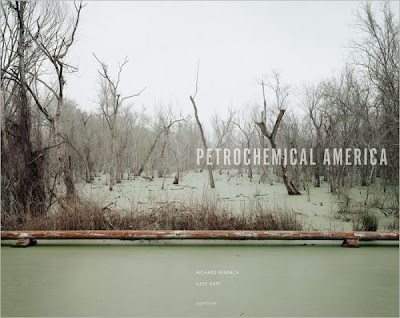Petrochemical [Religion in] America
Michael Pasquier
My children and I enjoy looking at picture books. They
usually take us places we will never go and introduce us to people we will
never meet. Petrochemical America is
different. It’s a book of photographs and maps of our home in Louisiana. It’s also not a
children’s book.
“Hey, I’ve been there! I’ve seen that!” My six-year-old
daughter is pointing at a photograph of the ExxonMobil Refinery taken from the
observation deck of Louisiana’s state capitol building.
“They have those round things by the zoo!” My
four-year-old son is pointing at a photograph of a mobile home situated next to
natural gas tanks in Norco, Louisiana.
“Look, Jesus!” My son is proud of himself. “And dead people.” My daughter adds. “And those things.” My children don’t know the word “refinery,” but they know it when they see it.
Petrochemical America is a book “about how oil and petrochemicals have
transformed the physical form and social dynamics of the American landscape.”
It focuses on “Cancer Alley,” the highly industrialized corridor of the
Mississippi River that runs from Baton Rouge and New Orleans to the Gulf of
Mexico. It’s by a photographer—Richard Misrach—and a landscape architect—Kate Orff.
Petrochemical America isn’t required reading for scholars and students of
religion in America. And it’s probably safe to say (though I could be wrong)
that Misrach and Orff aren’t reading things like Darren Dochuk’s article “Blessed by Oil, Cursed with Crude: God and Black Gold in the American Southwest.” We like our disciplinary silos. We’re comfortable in them. We
sometimes brag about our multidisciplinary methodologies, but we rarely stray
from the safety of the humanities umbrella.
**I'm not saying we should extend our methodologies beyond the humanities**
**I'm not saying we should extend our methodologies beyond the humanities**
But what if we did? What happens when we do? We can take an
example from two pages of Petrochemical America. They include two maps of Taft, Louisiana—one before and another
after Union-Carbide bought and developed property near this River Road town.
The caption reads: “This photo is of the former site of Our Lady of the Holy Rosary Catholic Church. The church was built just after the Civil War in 1877, and in 1963, it moved to Hahnville. The town fabric was replaced with the industrial footprint of Union-Carbide (later bought by Dow Chemical). While everyday neighborhoods like Taft have been largely obliterated, corporations often donate funds to preserve stately plantation homes. Literally and figuratively, they elevate one history and sublimate another.”
For those of us who study religion, we want more. We need more. We know there's more.
The caption reads: “This photo is of the former site of Our Lady of the Holy Rosary Catholic Church. The church was built just after the Civil War in 1877, and in 1963, it moved to Hahnville. The town fabric was replaced with the industrial footprint of Union-Carbide (later bought by Dow Chemical). While everyday neighborhoods like Taft have been largely obliterated, corporations often donate funds to preserve stately plantation homes. Literally and figuratively, they elevate one history and sublimate another.”
For those of us who study religion, we want more. We need more. We know there's more.
Orff concludes Petrochemical
America with the observation that “the collective places that once defined
regional identities have been leveled, leveed, denuded, and replanted.” She’s
right. But there’s more. This is where the humanities can come in. This is
where the poetics and politics of photographs and maps can join the stories and
artifacts of flesh-and-blood people barely present in archives and rarely
within reach of university campuses.
Or we can just rest with the book. It’s a damn good book.






Comments
But what precisely is being sublimated? What were the religious interests of Union Carbide? (I'm actually surprised the cemetery crucifix remains in such great shape.)
More importantly: Do most U.S. petrochemical companies share an essentially identical religious identity? Or are there significant differences in the ways they approach development and the religious and cultural landscapes they reshape?
P.S. I'd love a higher-resolution image of the map page. What do the red areas highlight? (I downloaded and zoomed, but its still illegible.)
In the next week or so, an essay of mine is going to be published in the design journal Places (http://places.designobserver.com/) that speaks directly to your questions. And I've got other stuff in the pipeline :)
Re: the individuality of people within each corporations: That's exactly what I was trying to gently suggest. Since we agree on that, I think it boils down to epistemological speculations. How many departments of Walmart Studies should we have? And particularly as scholars of religion, what would we learn by launching a Dow Studies area,or a Union Carbide area? This might be a divergence between RS and History, and my narrow-mindedness probably divulges that I've crossed over into the latter less successfully than you have.
Thanks again for your provocative post.